Are you looking for audit management software to simplify audits, ensure compliance, and gain real-time visibility into risks and controls?
A good audit management software can help you plan, execute, and track audits while centralizing evidence and automating workflows.
In this guide, I’ll cover the 10 best audit management tools that can help you streamline the entire audit lifecycle, while ensuring compliance and improving risk visibility.
TL;DR
- SmartSuite offers the best audit management software with its all-in-one audit lifecycle automation, centralized evidence management, and no-code workflow builder.
- Comprehensive tools like Workiva and AuditBoard are ideal for teams that want strong collaboration, real-time reporting, and pre-built compliance frameworks.
- On the other hand, platforms like MetricStream and ArcherIRM can help large enterprises unify global risk, compliance, and audit programs with advanced AI-driven insights and scalability.
Before we start, I wanted to go over some of the factors to consider when you’re evaluating audit management solutions:
What are the factors to consider when buying audit management tools?
The main factors to consider when buying audit management software include its audit scope & lifecycle, compliance mapping with evidence management, integrations, and reporting capabilities.
Let’s dive deeper into each one of them: ⬇️
#1: Audit scope & lifecycle
The first question you need to ask yourself is what processes do you need to run end-to-end?
Your audit software should match the way your organization actually works: planning, risk assessment, sampling, fieldwork, findings, remediation tracking and close-out.
Your team should also check that it supports scheduling, recurring audits, and versioned workpapers so you don’t lose historical context when rules or scopes change.
💡 Rule of thumb: if your audits are complex and cross functions, prioritize a solution with configurable workflows and clear handoffs.
#2: Controls, compliance mapping & evidence management
Next up, we want to take into consideration which standards and evidence types must be supported.
Look for built-in control libraries and flexible tagging so you can map controls to frameworks (e.g., SOX, ISO, SOC, PCI) and to business processes without rebuilding everything.
Evidence capture should allow attachments, screenshots, links to system logs, and time-stamped reviewer notes so auditors can reconstruct decisions.
➡️ Pro Tip: Strong evidence lineage (who collected what, when, and why) reduces rework during external reviews.
#3: Integration, data flows & automation capabilities
The next question is how connected the tool needs to be.
Audit work is rarely isolated; you’ll want connectors or APIs to pull user, entitlement, ticketing, change and financial data from HR systems, IAM, ERP, ITSM and cloud platforms to reduce manual evidence collection.
At minimum, you should validate available connectors, API maturity, and secure data handling (encryption, retention, and deletion policies).
#4: Reporting, analytics, security & scalability
Finally, the last question to ask yourself would be who needs what insights and at what scale?
Effective dashboards and exportable executive reports let stakeholders see status, risk heatmaps, and remediation velocity at a glance; make sure reports are customizable and filterable by business unit, risk, or timeframe.
Apart from this, you should verify role-based access, segregation of duties, a tamper-proof audit trail, and the vendor’s multi-tenant or multi-entity support if you operate across regions.
💡 If you expect growth or regulatory scrutiny, choose a platform whose security posture and reporting scale with your organization.
What are the best audit management platforms on the market?
The best audit management platforms on the market include SmartSuite with its all-in-one audit management capabilities, intuitive interface and affordable pricing structure, as well as Workiva and AuditBoard.
Here’s a comprehensive breakdown:
#1: SmartSuite: Best for banks and credit unions looking for all-in-one audit lifecycle automation, centralized evidence management, and no-code workflows.
#2: Workiva: Best for teams that want to connect data, evidence, and reporting in a single cloud platform with strong collaboration and real-time AI insights.
#3: AuditBoard: Best for organizations looking to make audit cycles faster and more transparent with preloaded compliance frameworks and automated workflows.
#4: MetricStream: Best for global enterprises seeking an all-in-one governance platform with AI-powered insights and scalability for risk, audit, and compliance.
#5: SAP Audit Management: Best for organizations already using SAP that want seamless audit integration with enterprise systems and real-time fraud detection.
#6: Diligent: Best for organizations prioritizing governance-driven audit management with executive-level dashboards and AI-powered compliance insights.
#7: ServiceNow GRC: Best for companies looking for integrated risk management and compliance automation within the broader ServiceNow ecosystem.
#8: LogicGate: Best for organizations needing configurable workflows and AI-driven insights to streamline audits, risk oversight, and third-party reviews.
#9: Onspring: Best for organizations looking to automate third-party audit questionnaires, vendor assessments, and evidence collection with no-code customization.
#10: ArcherIRM: Best for global compliance teams that need to track regulatory developments worldwide and align audits with enterprise risk management.
#1: SmartSuite
SmartSuite offers the best audit management software on the market for banks and credit unions with our modern, no-code project management platform.
Our GRC software bundles the things audit teams need: centralized evidence, configurable workflows, risk scoring, policy and control tracking, dashboards, automation and role-based access in a no-code platform.

💡 We have recently partnered with the Cyber Risk Institute to deliver a CRI profile for U.S. Banks' compliance needs.
Let’s go over the functionality that makes SmartSuite the best choice for compliance teams looking for an audit management solution: 👇
All-In-One Audit Management Software
Our no-code, easy-to-use platform empowers audit teams, compliance managers and CISOs to automate the entire audit lifecycle, from planning and evidence collection to reporting and remediation, without needing IT support or lengthy training.

Here are the audit use cases you’ll get with SmartSuite:
- Audit planning & execution: Build standardized audit engagements with templates for scope, sampling, objectives and test procedures.
You can schedule fieldwork, assign owners, and automatically populate workpaper checklists so audits start consistently and run on time.

- Workpapers & evidence management: Keep workpapers, attachments and corroborating evidence right next to the related test or finding.
➡️ Version control and in-record attachments eliminate scattered files and make it simple to demonstrate which evidence supported each conclusion.

- Automated testing & control assessments: Automate recurring control tests, evidence requests and control sampling.
- Create reports and dynamic dashboards: You can monitor executive views into your audit universe with heatmaps, trend lines, outstanding findings by severity and remediation SLA widgets.

- Integrate with your existing systems: SmartSuite’s flexible connectors and API support help consolidate data from systems you already depend on.
Your team will be able to:
- Pull contract or procurement data into vendor audit records.
- Push remediation tasks into ticketing systems for IT closure tracking.
- Sync asset inventories from CMDBs so control scoping and sampling reflect live infrastructure.
- Retrieve security telemetry or incident data into audit records to automate risk reclassification and evidence collection.

- Monitor, measure and score: Create automated risk calculations, control effectiveness scores and remediation KPIs so every audit engagement surfaces quantifiable metrics.

- Policy management: Establish a single source of truth for policies and controls.
You’ll be able to assign ownership, manage revisions, and ensure your policies consistently align with key business initiatives and regulatory requirements.

- PSTOS Compliance Tracker: Designed for regulatory compliance and built on SmartSuite.
This solution focuses on data security as the core of compliance frameworks with services such as compliance readiness, virtual CISO, and IT security implementation.
Learn more about it from this webinar that we did on the topic:
Prioritize & Mitigate Risks
With SmartSuite, you can create a centralized risk register to effectively identify potential risks to your organization.
You will be able to properly assess threats and establish risk mitigation strategies inside SmartSuite.

Your team can ensure that the appropriate controls are in place and measure their effectiveness by evaluating risk indicators and displaying results in SmartSuite’s rollup reports and dashboards.
💡 Pro Tip: Teams that use our platform use automation to move tasks through defined workflow stages that comply with their policies and procedures.

No-code automation to enforce audit process & reduce human error
SmartSuite’s no-code automation builder gives audit teams a visual, drag-and-drop way to codify audit workflows so work happens reliably, not by memory, sticky notes, or fragile spreadsheets.
You’ll be able to respond to events, enforce gates, and move engagements forward automatically without writing code.
Here are a few use cases:
- Auto-create and assign audit engagements: When a fiscal period opens or a risk score exceeds a threshold, automatically create an Audit Engagement record and assign the audit owner, sample lists, and due dates.
- Auto-populate workpapers and checklists: When an engagement is created, generate standardized workpapers and test-step checklists pre-filled from templates.
- Auto-assign fieldwork & evidence requests: When a test or finding is created, assign the responsible preparer and send an evidence request with a deadline and required attachment types.
- Evidence gating before status changes: Prevent a workpaper or finding from moving to “Ready for Review” unless required evidence is attached or a minimum number of supporting documents exists.

Pre-Built Audit Planning Template
We at SmartSuite have prepared an audit planning template that your team can get started with right away.
You will get access to:
- An Audit Dashboard, where you can see your audit plan with a calendar view and task tracker.
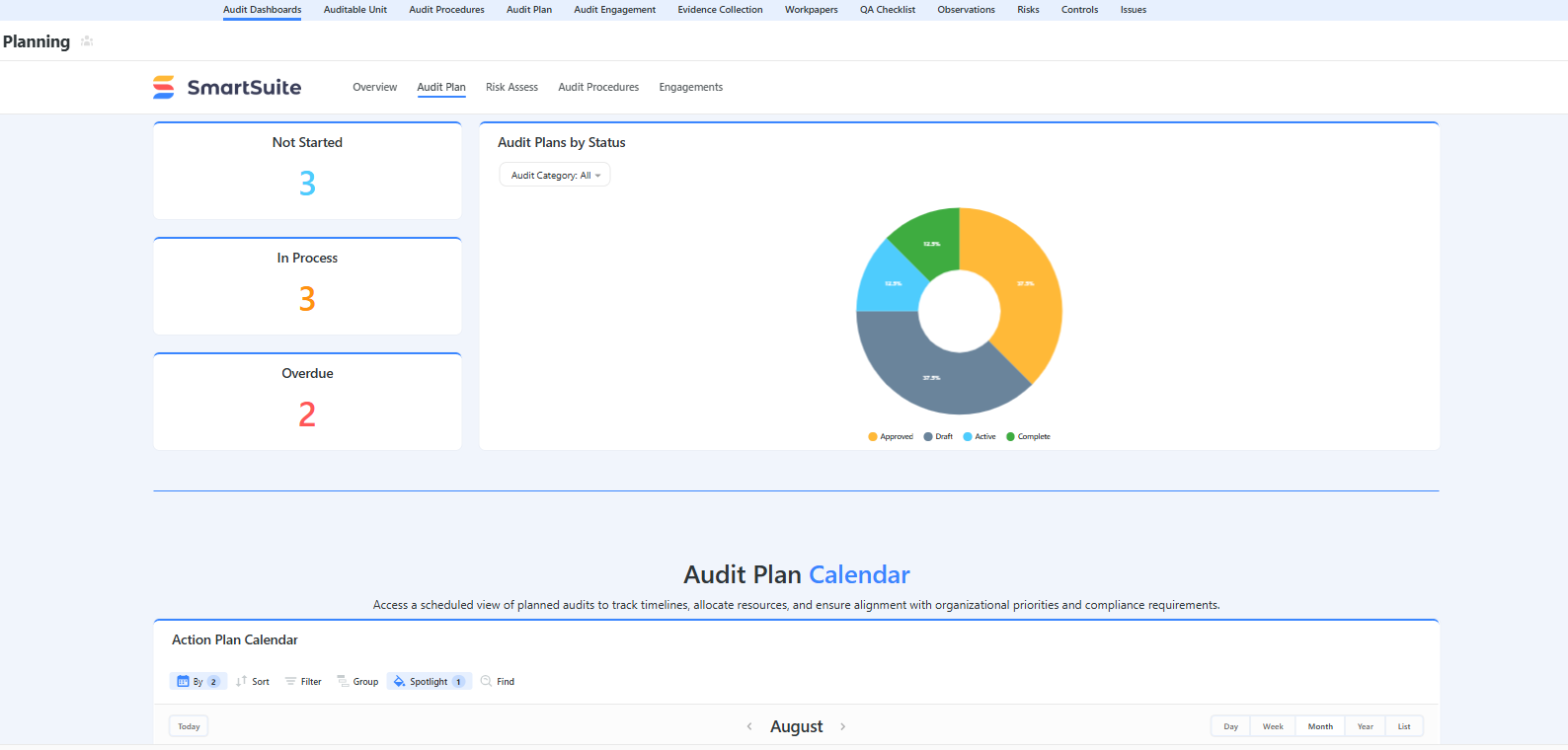
- All Auditable Units, where you can see unit names, priority, status, description, owner, and due dates with risk impact.

- Audit Procedures, which goes over the procedure title, assignee, status, evaluation date, and auditable unit.
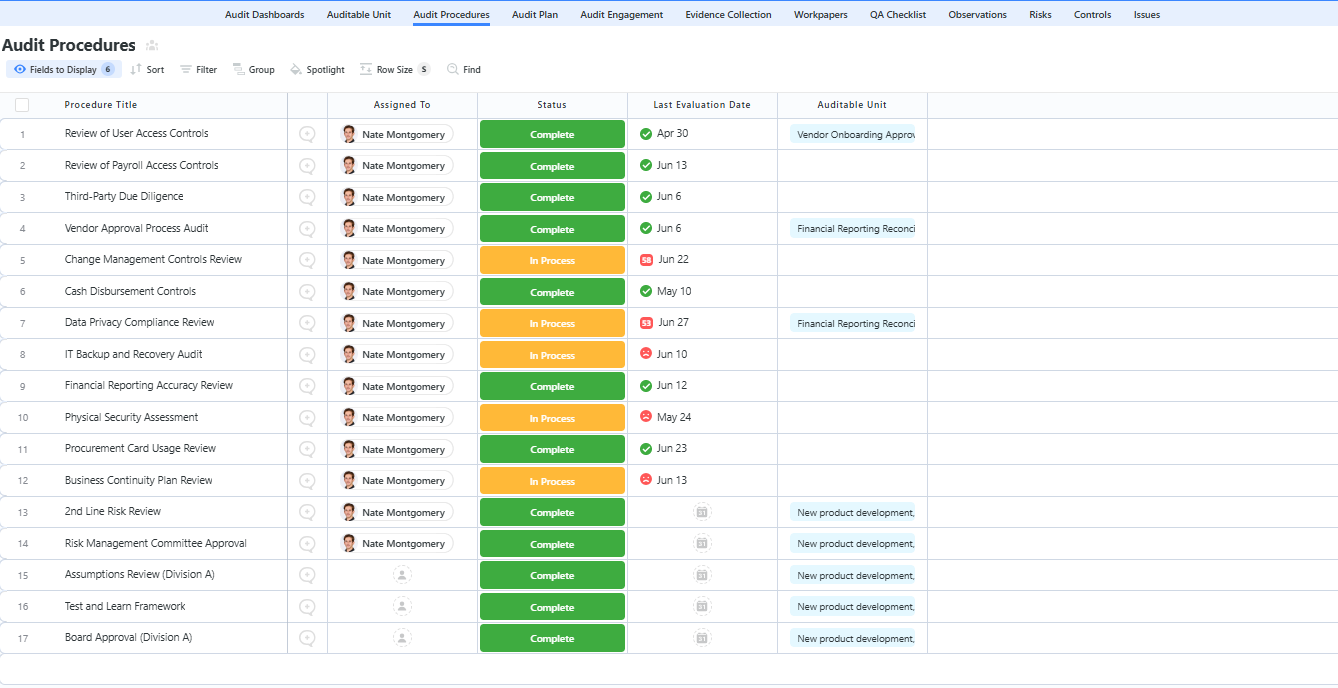
- Audit Engagement, which goes over the plan/scope, audit category, status, percentage complete, description, objectives, engagement lead, and result.

Alternatively, you can check out and customize our 14 other risk management templates for various use cases, such as contract management, policy management, and incident management.

Pricing
SmartSuite offers a free plan with access to 250+ automation actions, team collaboration, multi-dashboard views, and more.
There are four paid plans with a 14-day free trial (no CC required):
- Team: Starts at $12/user per month, including Gantt charts, timeline views, 5000 automation runs, and native time tracking.
- Professional: Starts at $30/user per month and adds two-factor authentication, Gmail & Outlook integrations, and unlimited editors.
- Enterprise: Starts at $45/user/month and includes access to audit logs, data loss prevention, and 50,000 monthly API calls.
- Signature: A customized plan tailored to your organization’s needs and team size with no predefined limits.

Pros & Cons
✅ A generous free plan that includes access to advanced features of the tool for up to 5 solutions.
✅ 15 out-of-the-box GRC templates for various use cases.
✅ Dynamic dashboards and reports that are easy to build and navigate, unlike some alternatives that require you to hire consultants to do it.
✅ All-in-one document and file management.
✅ You’ll be able to automate risk scoring, compliance tracking, audits, and vendor reviews.
✅ A modern solution with an intuitive user interface.
❌ Fewer native integrations when compared to other platforms in this list.
#2: Workiva
Best for: Connecting data, evidence, and reporting in a single cloud platform
Similar to: AuditBoard, LogicGate.
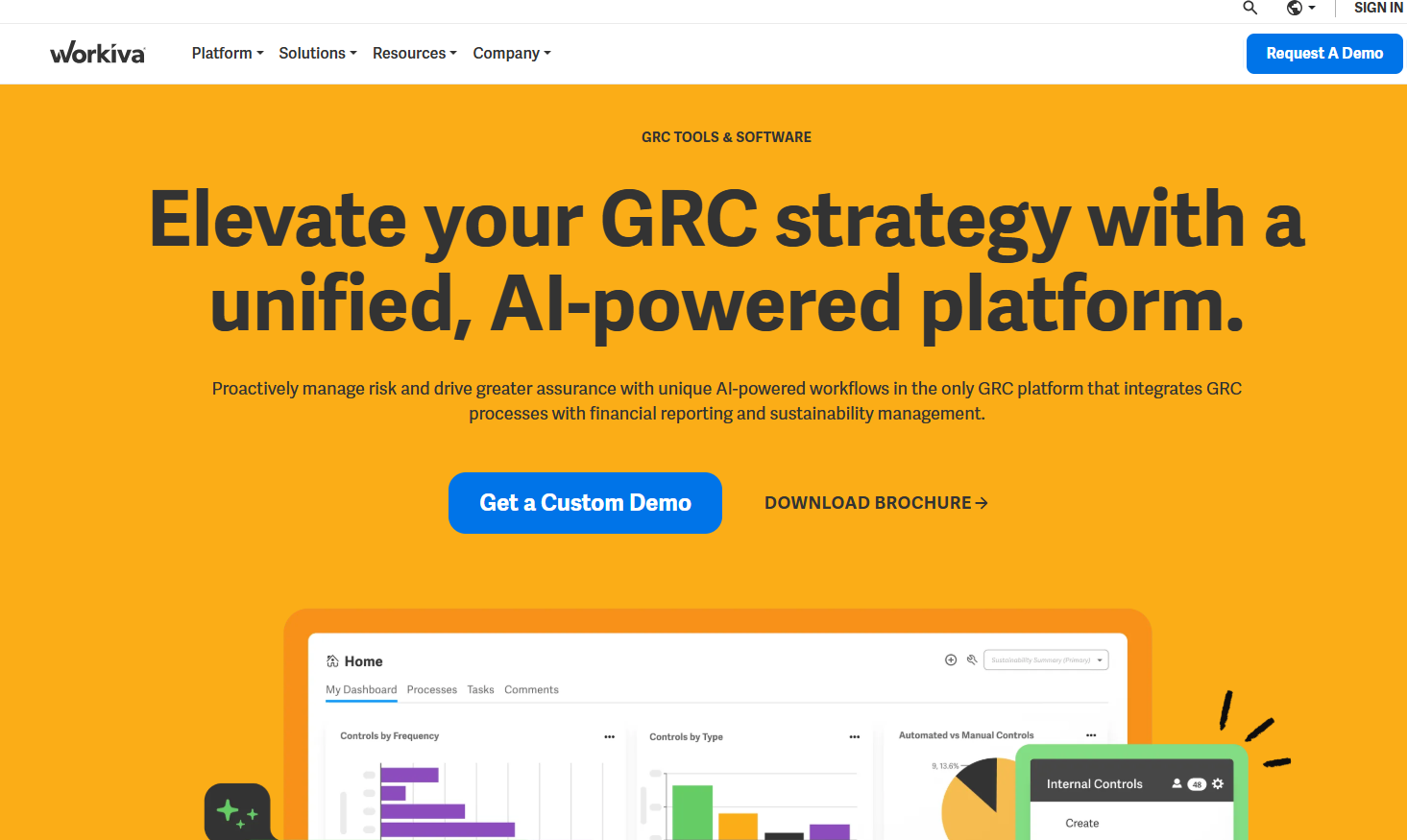
Workiva is strong for audit management because it connects data, evidence, and reporting in a single cloud platform with end-to-end versioning and an auditable change history, which speeds up testing and control documentation.
Its collaboration and data-lineage features reduce manual reconciliation and make financial and compliance reporting repeatable.
Features
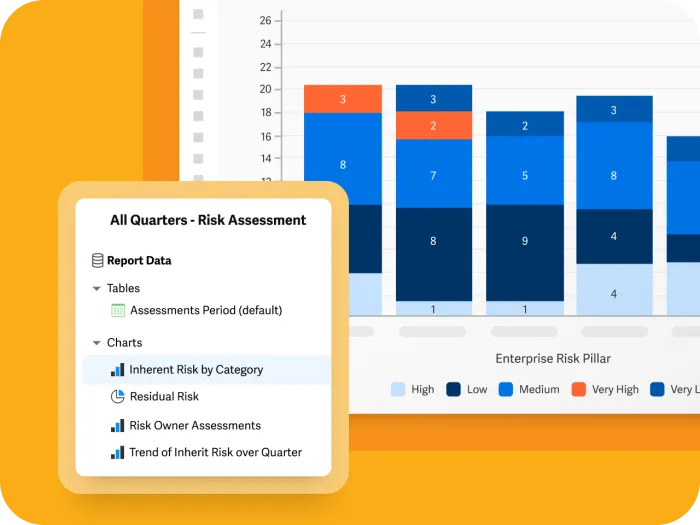
- Centralized control testing and evidence collection, extending to third-party audits for improved visibility and assurance.
- Leverage built‑in AI workflows to automate repetitive tasks like testing, evidence requests, reporting, and risk assessments.
- You can access up‑to‑the‑second dashboards and charts for controls, risks, and audit status to drive smarter business decisions.
- Map risks, controls, and policies to major standards (e.g., COSO, NIST, CMMC) directly in the platform for coverage tracking.
Standout Feature: Native AI Companion
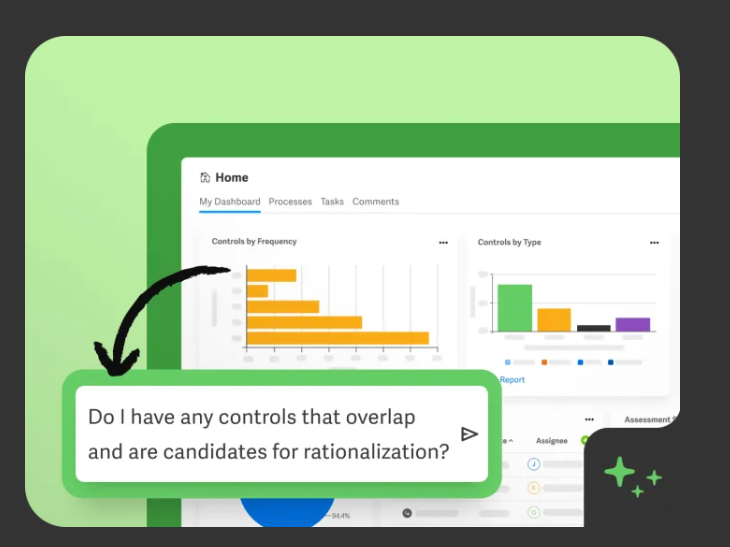
Workiva stood out to me with its AI companion that helps you uncover hidden risks, rationalise overlapping controls, and provide actionable insights in real time.
The secure, fit‑for‑purpose assistant lets audit and risk teams query their own data conversationally and elevate risk management from reactive to proactive.
Pricing
Workiva does not currently disclose its pricing, so you’d have to get in touch with them to request a demo so you can get a custom quote.
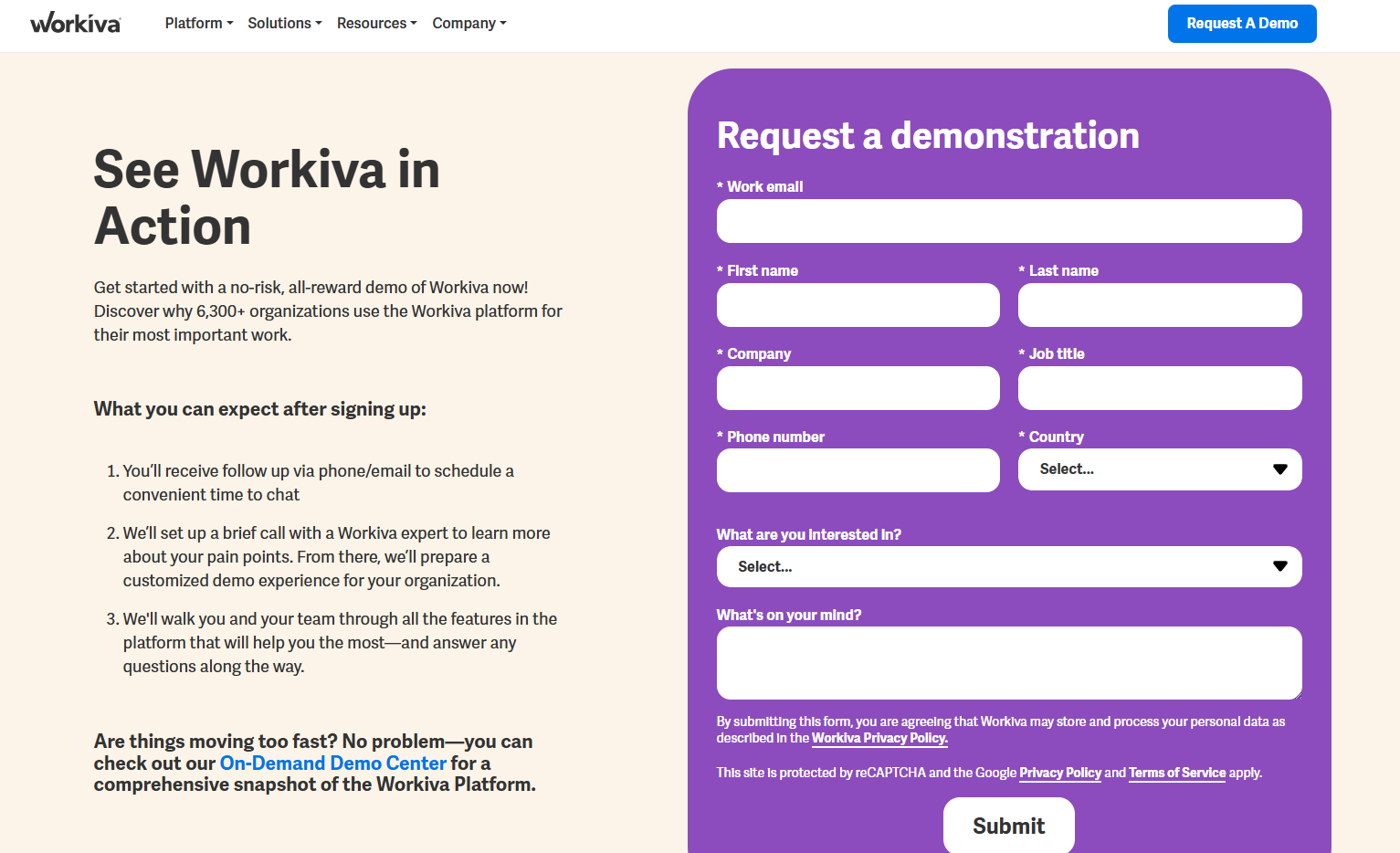
Pros & Cons
✅ AI companion that helps you uncover hidden risks
✅ Built-in AI workflows.
✅ You can invite unlimited users with advanced role‑based permissions and live dashboards for status, issues, and tasks.
❌ The platform can be very buggy, according to G2 reviews.
❌ Customer support is not as proactive as you’d expect.
#3: AuditBoard
Best for: Companies looking to make audit cycles faster and more transparent.
Similar to: OneTrust, IBM OpenPages.

AuditBoard excels in audit management with its intuitive interface and automation for risk assessments, workpapers, and reporting.
The platform reduces manual effort, making audit cycles faster and more transparent.
Features

- Automated issue tracking across internal and third-party audits to strengthen accountability and remediation.
- Advanced insights that help you optimize risk and compliance models.
- Customizable reports and pre-built dashboards that can help your compliance team uncover insights, track trends, and support data-driven decisions.
- Integrated workflows and APIs that help your team streamline data collection and task management through integrations.
Standout Feature: Pre-Built 30+ Frameworks

AuditBoard offers access to its preloaded library of 30+ frameworks (including SOC 2, ISO 27001, and GDPR) to help your organization stay audit-ready.
Pricing
AuditBoard has not yet disclosed its pricing, so you’d have to contact them to book a demo and get a quote.

Pros & Cons
✅ Get access to a single view of organizational risk.
✅ A modern interface with good AI capabilities.
✅ A preloaded library of 30+ frameworks to help you stay ready for audits.
❌ The average contract value of the tool is around $42,775/year, according to insiders, which is why some people have been looking for AuditBoard alternatives.
❌ Some customers of the platform find it difficult to use.
#4: MetricStream
Best for: Companies looking for an all-in-one platform to manage risk across the world.
Similar to: LogicGate, SAP GRC.

MetricStream provides robust audit management by integrating risk, compliance, and audit into one governance platform.
It’s designed for scalability, making it suitable for global enterprises.
Features

- Unified audit planning that incorporates supplier and partner risk assessments for holistic coverage.
- Pre-built regulatory change tracking, policy alignment, and impact assessments to help you minimize compliance violations.
- Cyber risk intelligence and unified IT risk management to proactively address threats and ensure regulatory compliance.
- Centralized third-party risk management, including performance tracking and business continuity risk assessment.
Standout Feature: AI-powered insights (AiSPIRE)

MetricStream stood out to me with its AI-powered insights solution, AiSPIRE, which can be used for predictive risk identification, duplicate control detection, and cognitive recommendations.
Pricing
MetricStream does not disclose its pricing structure, so you’d have to contact them to get a product demo and a quote.
However, our team did some digging and created an in-depth MetricStream pricing guide, where I found some reported numbers:
- Small enterprise deployment costs between $75,000 - $150,000 per year.
- Medium enterprise deployment costs between $250,000 - $500,000 per year.
- Large enterprise deployment can cost between $750,000 - $1,000,000 per year.

Pros & Cons
✅ Real-time cyber risk intelligence capabilities.
✅ Advanced analytics alongside real-time reporting.
✅ An AI-powered insights tool, AiSPIRE, that you can use for predictive risk identification.
❌ The tool’s pricing structure is not SME-friendly, according to user reviews.
❌ The interface can be hard to navigate, which is why some users look for MetricStream alternatives.
#5: SAP Audit Management
Best for: Seamless integration of audit data with enterprise systems.
Similar to: ArcherIRM.

SAP Audit Management is powerful for organizations already using SAP, enabling seamless integration of audit data with enterprise systems.
The platform emphasizes real-time insights and automation to reduce audit cycle times.
Features

- Embedded risk analytics that monitor third-party data sources and flag compliance gaps within audits.
- Compliance automation that helps you streamline documentation, testing, and remediation of critical process risks and controls.
- Centralized visibility into risks, controls, and business impacts across SAP’s S/4HANA environments.
Standout Feature: Fraud Detection & Predictive Analysis

SAP’s GRC offers fraud detection that screens transactional data in real-time using AI and customizable rules to uncover fraud, policy violations, and suspicious patterns.
Pricing
SAP’s GRC solution does not disclose its pricing tiers, so you’d have to contact their team for a demo and a personalized quote.

Pros & Cons
✅ Identify, assess, and mitigate risks with the tool’s all-in-one solution.
✅ Integrates well with other SAP GRC modules and core systems like S/4HANA.
✅ Customizable rules to uncover fraud, policy violations, and suspicious patterns.
❌ The UI can feel dated and complex for new users, according to G2 reviews.
❌ It can be expensive when compared to similar solutions in the market.
#6: Diligent
Best for: Governance-driven audit management with real-time dashboards and board-level visibility.
Similar to: Onspring, ArcherIRM.
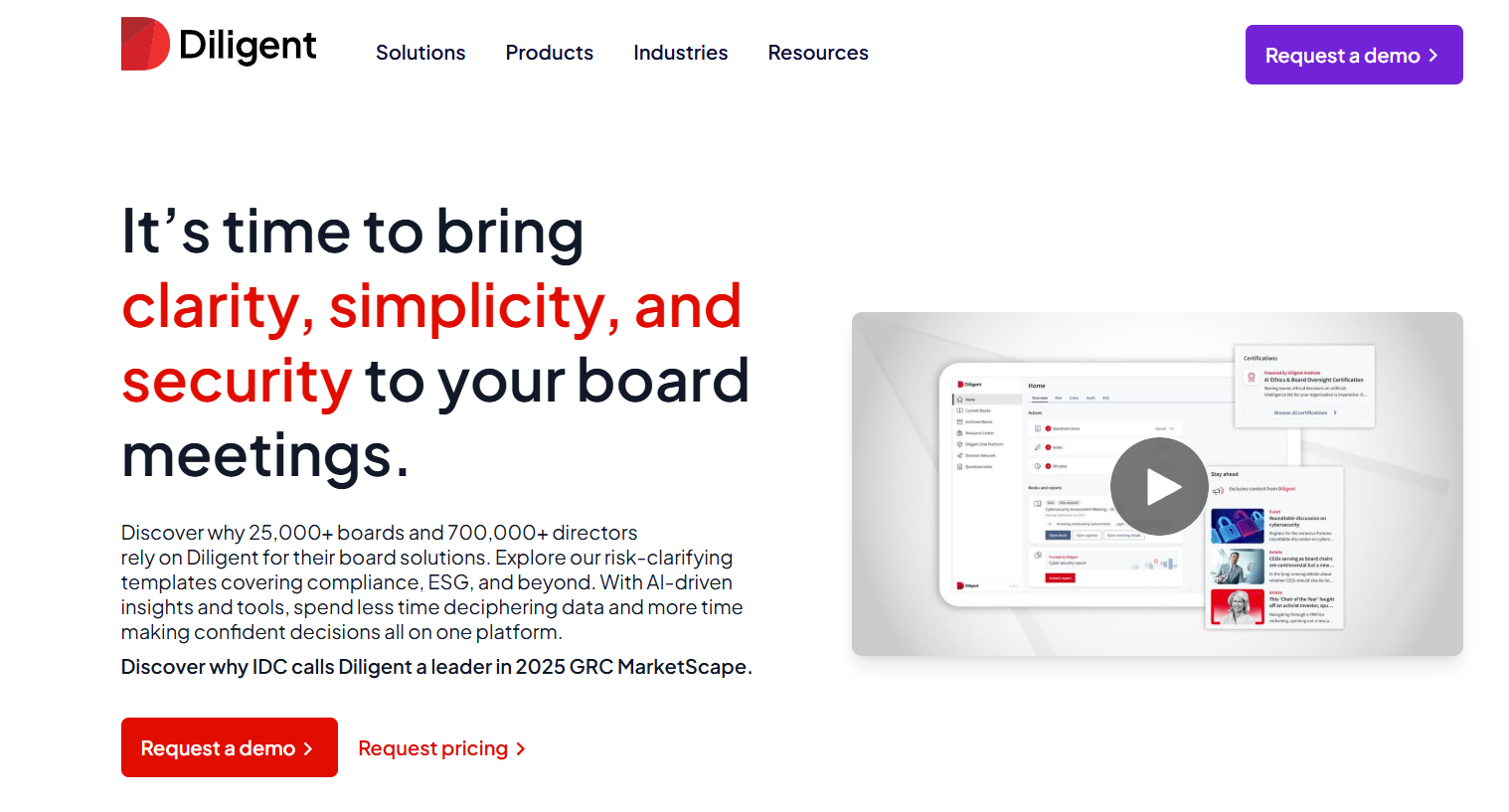
Diligent focuses on providing governance-driven audit management with real-time dashboards and board-level visibility.
It’s ideal for organizations prioritizing executive-level oversight of risk and controls.
Features
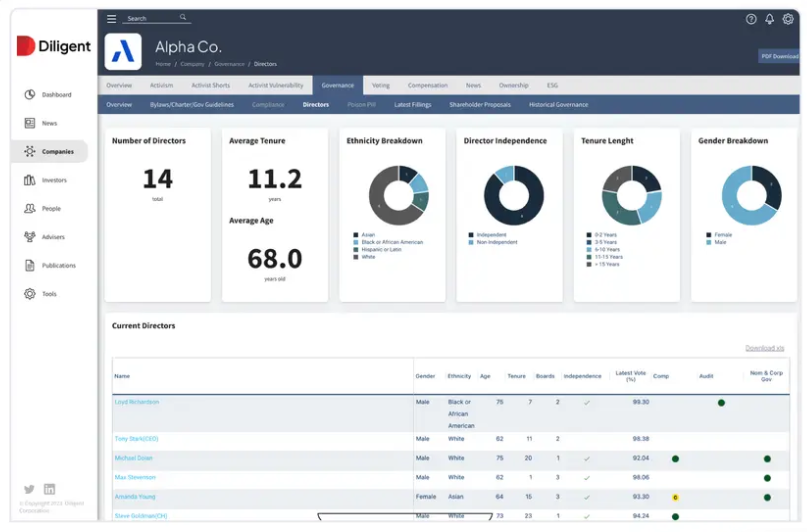
- Continuous monitoring of vendor-related audit findings to ensure third-party compliance obligations are met.
- You can configure ongoing data tests and automate business process monitoring (e.g. internal control testing) to detect anomalies and maintain compliance in real-time.
- It’s possible to use scripted tasks in Python or ACL to automate data aggregation, testing, and remediation notifications.
Standout Feature: Diligent AI
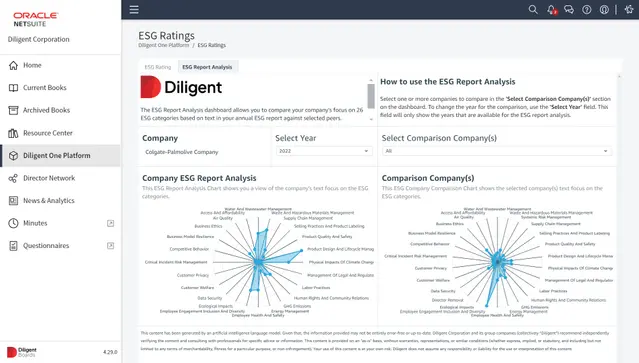
What stood out to me about Diligent is its AI assistant that helps you anticipate risk and stay compliant by generating summaries, mapping out regulatory requirements, and automatically benchmarking ESG and risk in real-time.
Pricing
There’s no official data on Diligent’s pricing plans; however, our team was able to find some reported numbers.
According to 3rd-party data from Vendr, the median buyer of Diligent spends $23,800/year for its solution, with the tool going up to $45,792/year.
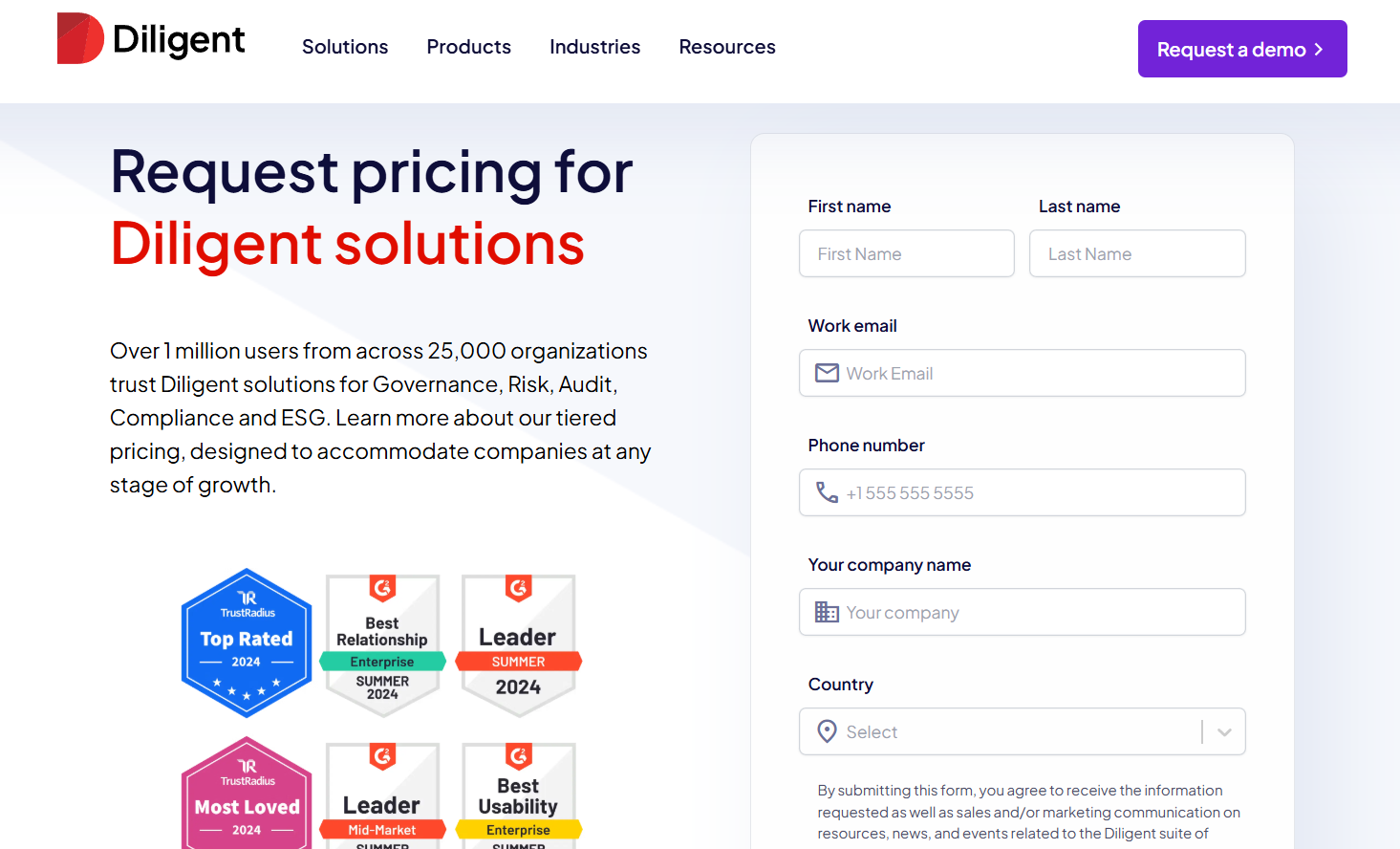
Pros & Cons
✅ One centralized GRC system that aims to replace multiple tools and simplifies oversight across risk and audit workflows.
✅ Integration-rich, allowing you to create seamless workflows between tools.
✅ An AI-powered assistant that can help you boost productivity.
❌ A steep learning curve and long initial setup and onboarding times.
❌ The platform’s pricing can get expensive, which is why some users have been looking for Diligent alternatives.
#7: ServiceNow
Best for: Companies looking for integrated risk management and compliance automations.
Similar to: LogicGate.

ServiceNow is designed with cybersecurity frameworks in mind, making it particularly strong for compliance-driven audit management.
Its simplicity helps smaller teams conduct structured audits without complexity.
Features

- Framework-mapped third-party assessments that align external audits with industry compliance standards.
- No-code workflow automation that enable cross-functional risk response and compliance management without having to hire consultants.
- The GRC suite operates on ServiceNow’s Now Platform, which enables seamless data sharing and real-time collaboration across all GRC products.
- Third-party risk management that helps you identify and mitigate risks from external vendors and partners.
➡️ You can learn more about ServiceNow in our comprehensive ServiceNow review.
Standout Feature: AI-Powered Actionable Insights

ServiceNow offers an AI-powered actionable insights that accelerate decision-making with predictive analytics and process optimization.
Pricing
ServiceNow’s pricing is not disclosed, so you’d have to book a demo with their team.
We found ServiceNow customer and public reviews, which show that the average cost of ServiceNow contracts can range between $50,000 and $500,000 annually.
Apparently, the pricing structure depends on the number of licenses, features, and other configuration requirements.

Pros & Cons
✅ Comprehensive risk, audit, and compliance management features.
✅ Real-time risk monitoring and prioritization.
✅ A good range of native integrations with other tools.
❌ Steep learning curve and complexity, with users citing that the platform can be difficult to configure and learn, unlike some ServiceNow alternatives.
❌ Training, skills development, and ongoing support can be costly.
#8: LogicGate
Best for: Organizations looking for configurable workflows that extend to third-party audit reviews for consistent risk oversight.
Similar to: ServiceNow GRC.

LogicGate’s flexible, workflow-based platform allows teams to customize audit processes to match business needs.
Its focus on automation and integration supports efficient issue tracking and audit reporting.
Features

- Configurable workflows that extend to third-party audit reviews for consistent risk oversight.
- Centralized risk repository for visibility across governance, compliance, and third-party risks.
- Out-of-the-box GRC templates that your team can start with to automate compliance reporting, as well as audit trails.
Standout Feature: Spark AI

LogicGate offers AI-powered insights that help your team predict risk and support your decision-making.
➡️ Spark AI also helps you generate executive summaries, which are good for busy CEOs looking for a quick update.
Pricing
LogicGate does not publicly disclose its pricing, so you’d have to book a personalized demo with their team to get a quote.
➡️ Take a look at our LogicGate pricing review, where our team found some reported numbers and also discusses whether it has good value for money.

Pros & Cons
✅ AI-driven insights that help you predict risk and support your decision-making.
✅ LogicGate Risk Cloud automates control follow-up tasks.
✅ Customers of the platform appreciate how responsive the customer service team has been.
❌ Some of LogicGate’s customers find the calculation functionality complicated, particularly with labels and percentages.
❌ The reporting features come with limitations, which is why some customers have been looking for LogicGate alternatives.
#9: Onspring
Best for: Organizations looking for automated third-party audit questionnaires and evidence collection to validate vendor controls.
Similar to: ArcherIRM.

Onspring provides no-code customization for audit processes, allowing organizations to tailor reporting, workflows, and issue management.
It emphasizes transparency and user-friendly dashboards for auditors.
Features

- Automated third-party audit questionnaires and evidence collection to validate vendor controls.
- It’s possible to create a comprehensive risk register and automate risk assessments.
- Assess, tier, and track vendors and integrate criticality ratings from cyber and financial monitoring services.
- Advanced reporting that helps you gauge performance with live dashboards of key metrics, risk scores, and audit activity status.
Standout Feature: Surveys for Easy Assessments

What stood out to me about Onspring is that it lets you use its point & click survey builder to build and send surveys to internal, external & third-party recipients.
The platform then automatically collects and scores results, assigns risk scores and can be customized to trigger follow-up actions.
Pricing
Onspring has 3 different pricing models that you can choose from based on which one better fits your needs:
- Pricing per user seat, where all users get access to all products on the Onspring platform.
- Pricing by product, where your team (with unlimited users) selects only a portion of the features to access.
- A hybrid model, where some users have unlimited access to the platform, while other users have limited access to other features.

After choosing your pricing structure, Onspring offers four paid tiers – Bronze, Silver, Gold, and Platinum – each adding more capacity and features:
- The Bronze plan includes core no-code workflow tools, basic reports, and modest storage limits.
- Upgrading to Silver and Gold adds increased database/attachment storage, extra API call capacity, additional admin training seats, and development/test environments.
- The Platinum tier provides maximum storage, the highest API limits, priority support, and all non-production environments (dev, test, sandbox).

Pros & Cons
✅ Good flexibility and customization options, according to G2 reviews.
✅ The platform is easy to learn, and the no-code build makes it easier to set up the solution.
✅ Best-in-class reporting with live dashboards.
❌ Expensive per-seat pricing, according to reviews on G2, which is why some compliance leaders have been looking for Onspring alternatives.
❌ The tool has an outdated interface that can be hard to use for some users.
#10: ArcherIRM
Best for: Global compliance teams looking to track regulatory developments from all over the world.
Similar to: AuditBoard.

ArcherIRM is a leader in integrated risk management, bringing together audit, risk, and compliance into one platform.
Its audit management tools are especially strong for enterprises seeking deep alignment with risk frameworks.
Features

- Risk-based audit planning that includes third-party vendors to prioritize high-impact external relationships.
- Integrated risk management across multiple dimensions, including IT, operational, and third-party risk.
- A customizable platform that adapts to your internal functions and extended third-party ecosystems.
- Consolidate standardized reports, audits, and assessments.
Standout Feature: Archer Evolv

ArcherIRM’s Evolv capability stood out to me as it helps teams track regulatory developments from all over the world.
The software aims to bring visibility to all requirements for better control over policies.
Pricing
ArcherIRM’s pricing structure is not publicly available, so you’d have to contact them to get a product demo and a quote.
Despite this, I was able to find some numbers in our ArcherIRM pricing guide.

Pros & Cons
✅ Real-time cyber risk intelligence capabilities.
✅ Enterprise-grade analytics and real-time reporting.
✅ An AI-powered analytics tool that can be used for predictive risk identification.
❌ An expensive price tag, which starts at approximately $55,000/year, which is why some SMEs have been looking for ArcherIRM alternatives.
❌ The platform seems to have an outdated interface that is not very intuitive.
Move From Spreadsheets To A Repeatable, Auditable Process With Our Audit Management Template For Free
That was it from our list of the 10 best audit management platforms on the market in 2025 for internal audit and compliance teams looking for a practical solution.
If your team needs to centralize audit programs, shorten time-to-remediation, and keep stakeholders informed, try SmartSuite with its free plan and pre-built audit templates.
SmartSuite helps audit teams move from spreadsheets to a repeatable, auditable process with straightforward configuration, centralized evidence collection, and workflow-driven testing.
Your team will be able to build reusable audit programs (SOX, operational, IT, vendor audits), assign ownership, automate testing and escalation, and track remediation from planning through ongoing monitoring all in one place.
Here’s what's in it for your team when you try SmartSuite:
- Ready-made audit templates for planning, workpapers, control testing, and findings so you can start standardizing programs the same day.
- Centralized evidence collection and versioned workpapers that tie source documents and test results directly to controls and issues.
- Workflow orchestration to automate recurring testing, notifications, approvals, and remediation handoffs.
- Audit calendar and scheduling with multi-board views (Kanban, Chart, Map, Timeline, Card, Calendar) to visualize audit phases and resource load.
- Real-time dashboards and reports to show control effectiveness, open issues, risk heat maps, and auditor activity for stakeholders and the board.
- No-code automation builder (scale to hundreds of thousands of trigger/action workflows) to auto-assign tests, escalate exceptions, and update statuses.
- Built-in productivity tools like time tracking, status tracking, and checklists to document testing effort and evidence collection.
- Collaboration and documentation features (whiteboards, SmartSuite Docs) so auditors, process owners, and remediation teams work from the same record.
- Resource management across audits and teams to balance workloads and plan capacity.
- 40+ field types (including formula and linked record fields) so you can model your audit universe, risk scoring, and custom metrics.
Sign up for a free plan to test the water or get a 14-day free trial to explore all its amazing features.
Or, if you’d like to talk to our team of experts, schedule a demo.
Read More
- 10 Best Riskonnect Alternatives For GRC In 2025
- Riskonnect Pricing: Is It Worth It In 2025?
- Atera Pricing: Is It Worth It in 2025?
- BMC Helix Pricing: Is It Worth It In 2025? [Reviewed]

Run your entire business on a single platform and stop paying for dozens of apps
- Manage Your Workflows on a Single Platform
- Empower Team Collaboration
- Trusted by 5,000+ Businesses Worldwide















